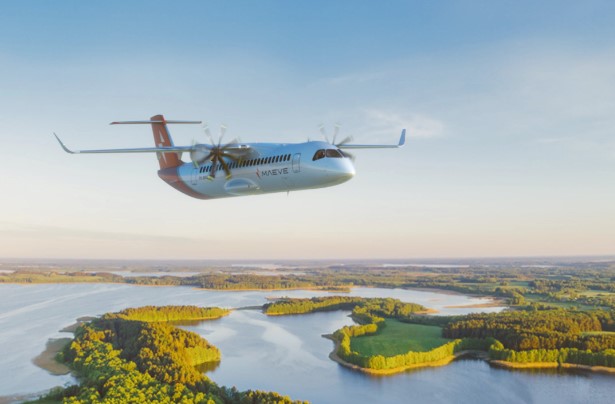Aerospace
Maeve Aerospace Unveils 80-Seat Hybrid Regional Airliner

Maeve Aerospace, a European aircraft developer, has announced the expansion of its operations to Oberpfaffenhofen Airport (Munich) and the introduction of a new hybrid-electric 80-seater aircraft.
This move is intended to accelerate work on the programme. With its regional jet performance and turbo-prop economics, the aircraft is built to support the growth of the regional aviation market in the future by providing a low-carbon, low-energy solution.
The M80, a hybrid-electric aircraft with 800 nautical miles (1482 km) of range, 40% increased energy efficiency, and no impact on infrastructure, is being developed by Maeve. Maeve has refined the aircraft concept to meet best-in-class requirements in terms of lead time, energy consumption, passenger capacity, and range.
The Maeve M80 is a revolutionary aircraft that combines the efficiency of a turboprop with the performance of a jet. With its newly integrated hybrid propulsion system and clean sheet design, the M80 significantly reduces mission energy and fuel consumption. Because of this, the M80 is the ideal substitute for turboprops and regional jets.
Maeve has a comprehensive integrated product development plan based on the knowledge and insights gained from multiple aircraft programmes and their industrial ramp-up, with an eye towards Entry-In-Service in 2031. Since a clean-sheet aircraft design like this calls for the greatest team in the business and a quick organisational ramp-up, a number of aviation professionals have joined Maeve for this next development phase. These specialists will work out of Maeve’s new location, which is close to Munich at the Oberpfaffenhofen Airport.

Aerospace
Boeing Transfers Rocket Stage to NASA, Paving Way for Human Moon Mission

Boeing has achieved a significant milestone by providing NASA with the second core stage of the Space Launch System (SLS) rocket.
This crucial component, crafted at NASA’s Michoud Assembly Facility (MAF), is set to propel the Artemis II crew into lunar orbit, marking humanity’s return to deep space after a 50-year hiatus.
The monumental Boeing-built rocket stage, the largest element of the Artemis II mission, will embark on a journey aboard the Pegasus barge, traveling 900 miles to NASA’s Kennedy Space Center.
Comparison of two legendary aircraft B777x vs B747 aircraft:Click here
Upon arrival, it will be meticulously integrated with other essential Artemis II components, including the upper stage, solid rocket boosters, and NASA’s Orion spacecraft within the iconic Vehicle Assembly Building. This intricate integration process is a vital step toward the eagerly anticipated Artemis II launch, slated for 2025.
“Boeing-built products helped land humankind on the moon in 1969, and we’re proud to continue that legacy through the Artemis generation,” remarked Dave Dutcher, vice president and program manager for Boeing’s SLS program. “Together, with NASA and our industry partners and suppliers, we are building the world’s most capable rocket and paving the way to deep space through America’s rocket factory in New Orleans.”
NASA, Lockheed Martin Reveal X-59 Quiet Supersonic Aircraft:Click here
The delivery of Core Stage 2 marks a significant achievement in the evolution of the SLS rocket. Towering over 200 feet and powered by four RS-25 engines, this core stage, coupled with two solid-fueled booster rockets, will generate a staggering 8.8 million pounds of thrust. This immense power is crucial to launching Artemis II and future missions into the vast expanse of space.
The SLS rocket stands unparalleled in its capability to transport both crew and substantial cargo to the moon and beyond in a single launch. Its extraordinary capacity will facilitate the delivery of human-rated spacecraft, habitats, and scientific missions to destinations including the moon and Mars, ushering in a new era of space exploration.
-

 Travel1 week ago
Travel1 week agoAir India to Expand US Operations with Three New Routes After a Decade
-

 Travel2 weeks ago
Travel2 weeks agoWhy We Should Avoid These Stamps in a Passport
-

 Airlines1 month ago
Airlines1 month agoInvestigations Reveal Fake Chinese Titanium in Boeing and Airbus Jets
-

 Tech4 weeks ago
Tech4 weeks agoChina’s CATL Plans 1,800-Mile Electric Plane Launch by 2027
-

 Airport3 days ago
Airport3 days agoTop 10 Largest Airports in the World by Size
-

 Aerospace4 weeks ago
Aerospace4 weeks agoChina’s Fighter Jets Turn Wings into Autonomous Drones
-

 Airlines4 days ago
Airlines4 days agoAir India Rolls Out A350s for Delhi-New York JFK and Newark Routes
-

 Defence3 weeks ago
Defence3 weeks agoBoeing Enhances Chinook with New Engines and Block II Upgrades at $96 Million







